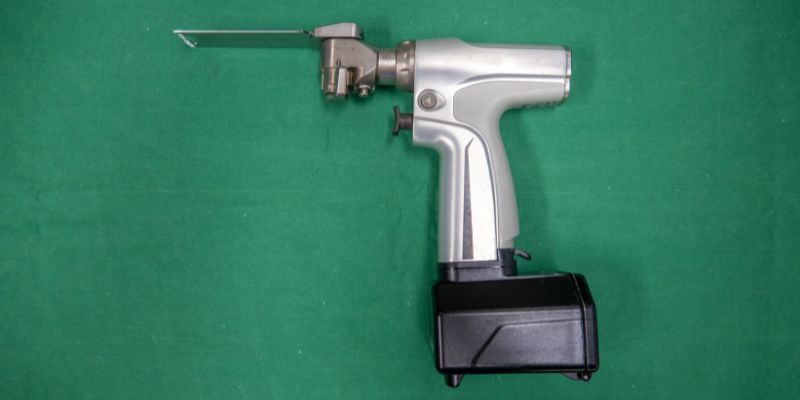Oscillating saws are ideal for precise cutting while reciprocating saws are versatile and suitable for aggressive cutting tasks. When considering which saw to choose, it’s important to understand the specific qualities and applications of both oscillating saws and reciprocating saws.
Oscillating saws are favored for their ability to make precise and intricate cuts in various materials such as wood, metal, and plastic. They offer a high level of control and are often used in applications that require meticulous detail, like cutting intricate patterns or notching.
On the other hand, reciprocating saws are known for their versatility and ability to handle aggressive cutting tasks. With a more powerful motor and longer blade stroke, they can cut through thicker materials, remove tiles or drywall, or even prune trees with the right blade attachment. Reciprocating saws are commonly used in construction, demolition, and renovation projects due to their ability to quickly and efficiently cut through different materials. Whether you need precision or versatility, understanding the differences between oscillating saws and reciprocating saws will help you choose the right tool for your specific needs.
Features And Functions
When it comes to power tools, oscillating saws and reciprocating saws are two popular options that can make your cutting tasks easier and more efficient. Both of these saws have their own unique features and functions that cater to different cutting needs. In this section, we’ll take a closer look at the features and functions of oscillating saws and reciprocating saws, so you can determine which one is the right choice for your projects.
Oscillating Saw
The oscillating saw, also known as a multi-tool, is a versatile cutting tool that offers a wide range of functions. This tool operates by moving its blade from side to side in a rapid oscillating motion, which enables it to perform various cutting tasks with precision. Here are some key features and functions of oscillating saws:
|
Reciprocating Saw
The reciprocating saw, also known as a saber saw or sawzall, is a powerful cutting tool designed for heavy-duty applications. This saw features a back-and-forth motion of the blade, similar to a traditional handsaw, which makes it ideal for aggressive cutting tasks. Here are some key features and functions of reciprocating saws:
|
Now that you have a better understanding of the features and functions of oscillating saws and reciprocating saws, you can make an informed decision based on the specific needs of your projects. Whether you require precise cuts in tight spaces or need a powerful tool for aggressive cutting, there is a saw that can meet your requirements.

Applications And Uses
When it comes to power tools, the oscillating saw and the reciprocating saw are two popular choices among professionals and DIY enthusiasts alike. Each saw has its own unique features and capabilities that make it ideal for specific applications and uses. In this section, we will explore the different applications and uses of these two saws, helping you determine which one is best suited for your needs.
Oscillating Saw
The oscillating saw, also known as a multi-tool, is a versatile and precise cutting tool that can handle a wide range of tasks. Its unique oscillating motion allows it to make precise cuts in various materials, including wood, metal, plastic, and drywall. This makes it an excellent choice for tasks such as:
- Cutting through door jambs during flooring installations
- Trimming baseboards and crown molding
- Removing grout for tile installations or repair work
- Sanding and scraping surfaces for refinishing projects
- Plunge cutting into tight spaces
The oscillating saw’s ability to accept various attachments, such as cutting blades, sanding pads, and scraping blades, further enhances its versatility and makes it an essential tool for professionals across multiple trades including carpentry, flooring, plumbing, and general construction.
Reciprocating Saw
The reciprocating saw, also known as a saber saw or sawzall, is a powerful cutting tool designed for demolition and heavy-duty cutting tasks. Its name comes from the back-and-forth or reciprocating motion of its blade. With its raw cutting power and long blade stroke, the reciprocating saw is best suited for:
- Cutting through thick or dense materials like wood, metal, and PVC pipes
- Demolition work, including removing walls or cutting through nails and screws
- Pruning trees or cutting branches
- Creating rough cuts or notches
- Cutting through nails embedded in wood or metal
The reciprocating saw’s aggressive cutting action and wide range of blade options, including specialized blades for metal, wood, and even masonry, make it an indispensable tool on construction sites, for contractors, and for emergency services.
Ultimately, the choice between an oscillating saw and a reciprocating saw depends on the specific task at hand. Both tools have their own strengths and applications, and owning both may be beneficial for someone who frequently undertakes diverse cutting projects. However, for those looking to invest in a single tool that offers maximum versatility, the oscillating saw is the way to go. It’s a powerhouse that can handle a wide range of detail-oriented and precision-cutting tasks with ease.

Pros And Cons
If you are in the market for a versatile power tool that can handle a variety of cutting tasks, you might be torn between an oscillating saw and a reciprocating saw. Both of these saws have their advantages and disadvantages, so it’s important to understand the pros and cons of each before making a decision. In this article, we will explore the benefits and drawbacks of both the oscillating saw and the reciprocating saw, helping you make an informed choice.
Oscillating Saw
An oscillating saw, also known as a multi-tool, is a compact and versatile power tool that uses quick side-to-side movements to make precise cuts. Its oscillating motion allows it to tackle a wide range of cutting tasks, including plunge cuts, flush cuts, sanding, scraping, and more. Here are some of the pros and cons of using an oscillating saw:
| Pros | Cons |
|---|---|
| 1. Versatility: The oscillating saw can handle various cutting and finishing tasks, making it suitable for DIY enthusiasts and professionals alike. | 1. Speed: Due to its oscillating motion, an oscillating saw may not be as fast as a reciprocating saw for certain cutting tasks. |
| 2. Precision: The oscillating saw excels at making precise and controlled cuts, even in tight spaces or intricate patterns. | 2. Limited depth of cut: While an oscillating saw is great for cutting thinner materials, it may struggle with thick or heavy-duty applications. |
| 3. Less vibration: Compared to a reciprocating saw, an oscillating saw generates less vibration, resulting in reduced user fatigue and a smoother cutting experience. | 3. Higher price: Oscillating saws tend to be more expensive than reciprocating saws, which may be a consideration for budget-conscious buyers. |
Reciprocating Saw
A reciprocating saw, also known as a Sawzall, is a powerful cutting tool that relies on a back-and-forth motion of the blade to make fast and aggressive cuts. This saw is commonly used in construction, demolition, plumbing, and other heavy-duty applications. Let’s delve into the pros and cons of using a reciprocating saw:
| Pros | Cons |
|---|---|
| 1. Power: Reciprocating saws are known for their high cutting power, allowing them to handle tough materials like wood, metal, and PVC pipes. | 1. Vibration: Due to the vigorous back-and-forth motion, a reciprocating saw can generate considerable vibration, potentially causing user fatigue. |
| 2. Speed: When it comes to cutting through thick materials or performing demolition work, a reciprocating saw excels in speed and efficiency. | 2. Less precision: While a reciprocating saw is great for fast and aggressive cuts, achieving intricate details or tight precision might be challenging. |
| 3. Cost-effective: Reciprocating saws are generally more affordable than oscillating saws, making them a popular choice among DIYers and professionals on a budget. | 3. Bulky and heavy: Due to their robust and powerful nature, reciprocating saws can be heavier and more cumbersome to maneuver. |
Frequently Asked Questions For Oscillating Saw Vs Reciprocating Saw
What Is The Difference Between Reciprocating And Oscillating Saw Surgery?
Reciprocating and oscillating saw surgery are different techniques used in surgery. A reciprocating saw moves back and forth in a straight-line motion, while an oscillating saw moves in a side-to-side motion. These techniques serve specific purposes and are used based on the surgical requirements.
When Should You Not Use A Reciprocating Saw?
Reciprocating saws should not be used in delicate or precision work, such as cutting fine materials or making intricate cuts. Additionally, avoid using them for tasks that require high accuracy or control, like making detailed shapes or cutting close to electrical wires and plumbing.
What Are The Benefits Of An Oscillating Saw?
An oscillating saw offers several benefits, such as versatility in cutting various materials, enabling precision and accuracy, easy maneuverability in tight spaces, and compatibility with various attachments. It is perfect for home improvement projects, plumbing work, and construction tasks.
What Will An Oscillating Saw Cut?
An oscillating saw can cut through various materials such as wood, metal, plastic, and drywall.
Conclusion
To summarize, both the oscillating saw and the reciprocating saw have their own unique features and advantages. The oscillating saw is versatile and precise, making it perfect for intricate tasks. On the other hand, the reciprocating saw offers power and speed, ideal for heavy-duty cutting.
Ultimately, the choice between the two depends on your specific needs and projects. So, equip yourself with the right tool and tackle your tasks effectively.



One thought on “Oscillating Saw Vs Reciprocating Saw: Which Power Tool Reigns Supreme?”